Transformation of Thia[7]helicene to Aza[7]helicenes and [7]Helicene-like Compounds via Aromatic Metamorphosis
Abstract
:1. Introduction
2. Results and Discussion
3. Materials and Methods
3.1. General Procedures
3.2. Synthesis
3.2.1. 9,9-Dimethyl-9H-diphenanthro[3,4-b:4′,3′-d]silole (2a)
3.2.2. 9,9-Diphenyl-9H-diphenanthro[3,4-b:4′,3′-d]silole (2b)
3.2.3. 9-Phenylnaphtho[1,2-e]phenanthro[3,4-b]phosphindole 9-oxide (3)
3.2.4. Spiro[cyclopenta[1,2-c:4,3-c′]diphenanthrene-9,9′-xanthene] (4b)
3.2.5. 9-(4-Methylphenyl)-9H-dinaphtho[2,1-c:1′,2′-g]carbazole (5b)
3.2.6. 9-(4-Methoxyphenyl)-9H-dinaphtho[2,1-c:1′,2′-g]carbazole (5c)
3.3. Computational Studies
3.4. X-ray Crystallography
4. Conclusions
Supplementary Materials
Author Contributions
Funding
Institutional Review Board Statement
Informed Consent Statement
Data Availability Statement
Acknowledgments
Conflicts of Interest
Sample Availability
References
- Shen, Y.; Chen, C.F. Helicenes: Synthesis and Applications. Chem. Rev. 2012, 112, 1463–1535. [Google Scholar] [CrossRef]
- Gingras, M. One hundred years of helicene chemistry. Part 3: Applications and properties of carbohelicenes. Chem. Soc. Rev. 2013, 42, 1051–1095. [Google Scholar] [CrossRef] [PubMed]
- Gingras, M.; Félix, G.; Peresutti, R. One hundred years of helicene chemistry. Part 2: Stereoselective syntheses and chiral separations of carbohelicenes. Chem. Soc. Rev. 2013, 42, 1007–1050. [Google Scholar] [CrossRef] [PubMed]
- Verbiest, T.; Elshocht Sven, V.; Kauranen, M.; Hellemans, L.; Snauwaert, J.; Nuckolls, C.; Katz Thomas, J.; Persoons, A. Strong Enhancement of Nonlinear Optical Properties Through Supramolecular Chirality. Science 1998, 282, 913–915. [Google Scholar] [CrossRef] [PubMed]
- Hatakeyama, T.; Hashimoto, S.; Oba, T.; Nakamura, M. Azaboradibenzo[6]helicene: Carrier inversion induced by helical homochirality. J. Am. Chem. Soc. 2012, 134, 19600–19603. [Google Scholar] [CrossRef] [PubMed]
- Zhang, L.; Song, I.; Ahn, J.; Han, M.; Linares, M.; Surin, M.; Zhang, H.J.; Oh, J.H.; Lin, J. π-Extended perylene diimide double-heterohelicenes as ambipolar organic semiconductors for broadband circularly polarized light detection. Nat. Commun. 2021, 12, 142. [Google Scholar] [CrossRef] [PubMed]
- Hua, W.; Liu, Z.; Duan, L.; Dong, G.; Qiu, Y.; Zhang, B.; Cui, D.; Tao, X.; Cheng, N.; Liu, Y. Deep-blue electroluminescence from nondoped and doped organic light-emitting diodes (OLEDs) based on a new monoaza[6]helicene. RSC Adv. 2015, 5, 75–84. [Google Scholar] [CrossRef]
- Aillard, P.; Voituriez, A.; Dova, D.; Cauteruccio, S.; Licandro, E.; Marinetti, A. Phosphathiahelicenes: Synthesis and uses in enantioselective gold catalysis. Chem. Eur. J. 2014, 20, 12373–12376. [Google Scholar] [CrossRef]
- Oestreich, M.; Gross, B.M. The Trityl Cation Embedded into a [7]Helicene-Like Backbone: Preparation and Application as a Lewis Acid Catalyst. Synthesis 2021, 53, 2512–2516. [Google Scholar] [CrossRef]
- Zhao, W.L.; Li, M.; Lu, H.Y.; Chen, C.F. Advances in helicene derivatives with circularly polarized luminescence. Chem. Commun. 2019, 55, 13793–13803. [Google Scholar] [CrossRef] [PubMed]
- Flammang-Barbieux, M.; Nasielski, J.; Martin, R.H. Synthesis of heptahelicene (1) benzo [c] phenanthro [4, 3-g] phenanthrene. Tetrahedron Lett. 1967, 8, 743–744. [Google Scholar] [CrossRef]
- Willmore, N.D.; Liu, L.B.; Katz, T.J. A Diels-Alder Route to [5]-Helicenes and [6]-Helicenes. Angew. Chem. Int. Ed. 1992, 31, 1093–1095. [Google Scholar] [CrossRef]
- Ichikawa, J.; Yokota, M.; Kudo, T.; Umezaki, S. Efficient helicene synthesis: Friedel-Crafts-type cyclization of 1,1-difluoro-1-alkenes. Angew. Chem. Int. Ed. 2008, 47, 4870–4873. [Google Scholar] [CrossRef]
- Stará, I.G.; Starý, I.; Kollárovič, A.; Teplý, F.; Šaman, D.; Tichý, M. A novel strategy for the synthesis of molecules with helical chirality. Intramolecular [2+2+2] cycloisomerization of triynes under cobalt catalysis. J. Org. Chem. 1998, 63, 4046–4050. [Google Scholar] [CrossRef]
- Tanaka, K.; Kamisawa, A.; Suda, T.; Noguchi, K.; Hirano, M. Rh-catalyzed synthesis of helically chiral and ladder-type molecules via [2+2+2] and formal [2+1+2+1] cycloadditions involving C-C triple bond cleavage. J. Am. Chem. Soc. 2007, 129, 12078–12079. [Google Scholar] [CrossRef] [PubMed]
- Tanaka, K.; Fukawa, N.; Suda, T.; Noguchi, K. One-step construction of five successive rings by rhodium-catalyzed intermolecular double [2+2+2] cycloaddition: Enantioenriched [9]helicene-like molecules. Angew. Chem. Int. Ed. 2009, 48, 5470–5473. [Google Scholar] [CrossRef]
- Sawada, Y.; Furumi, S.; Takai, A.; Takeuchi, M.; Noguchi, K.; Tanaka, K. Rhodium-Catalyzed Enantioselective Synthesis, Crystal Structures, and Photophysical Properties of Helically Chiral 1,1′-Bitriphenylenes. J. Am. Chem. Soc. 2012, 134, 4080–4083. [Google Scholar] [CrossRef]
- Storch, J.; Bernard, M.; Sýkora, J.; Karban, J.; Čermák, J. Intramolecular Cascade Hydroarylation/Cycloisomerization Strategy for the Synthesis of Polycyclic Aromatic and Heteroaromatic Systems. Eur. J. Org. Chem. 2013, 2013, 260–263. [Google Scholar] [CrossRef]
- Shimizu, M.; Nagao, I.; Tomioka, Y.; Hiyama, T. Palladium-catalyzed annulation of vic-bis(pinacolatoboryl)alkenes and -phenanthrenes with 2,2′-dibromobiaryls: Facile synthesis of functionalized phenanthrenes and dibenzo[g,p]chrysenes. Angew. Chem. Int. Ed. 2008, 47, 8096–8099. [Google Scholar] [CrossRef]
- Collins, S.K.; Grandbois, A.; Vachon, M.P.; Côté, J. Preparation of helicenes through olefin metathesis. Angew. Chem. Int. Ed. 2006, 45, 2923–2926. [Google Scholar] [CrossRef] [PubMed]
- Grandbois, A.; Collins, S.K. Enantioselective Synthesis of [7]Helicene: Dramatic Effects of Olefin Additives and Aromatic Solvents in Asymmetric Olefin Metathesis. Chem. Eur. J. 2008, 14, 9323–9329. [Google Scholar] [CrossRef] [PubMed]
- Bhanuchandra, M.; Murakami, K.; Vasu, D.; Yorimitsu, H.; Osuka, A. Transition-Metal-Free Synthesis of Carbazoles and Indoles by an SNAr-Based “Aromatic Metamorphosis” of Thiaarenes. Angew. Chem. Int. Ed. 2015, 54, 10234–10238. [Google Scholar] [CrossRef] [PubMed] [Green Version]
- Yorimitsu, H.; Vasu, D.; Bhanuchandra, M.; Murakami, K.; Osuka, A. Aromatic Metamorphosis of Dibenzothiophenes. Synlett 2016, 27, 1765–1774. [Google Scholar] [CrossRef]
- Bhanuchandra, M.; Yorimitsu, H.; Osuka, A. Synthesis of Spirocyclic Diarylfluorenes by One-Pot Twofold SNAr Reactions of Diaryl Sulfones with Diarylmethanes. Org. Lett. 2016, 18, 384–387. [Google Scholar] [CrossRef] [PubMed]
- Kaga, A.; Nogi, K.; Yorimitsu, H. Synthesis of N-Alkyl and N-H-Carbazoles through SNAr-Based Aminations of Dibenzothiophene Dioxides. Chem. Eur. J. 2019, 25, 14780–14784. [Google Scholar] [CrossRef] [PubMed]
- Kaga, A.; Iida, H.; Tsuchiya, S.; Saito, H.; Nakano, K.; Yorimitsu, H. Aromatic Metamorphosis of Thiophenes by Means of Desulfurative Dilithiation. Chem. Eur. J. 2021, 27, 4567–4572. [Google Scholar] [CrossRef]
- Nagata, Y.; Kato, S.; Miyake, Y.; Shinokubo, H. Synthesis of Tetraaza[8]circulenes from Tetrathia[8]circulenes through an SNAr-Based Process. Org. Lett. 2017, 19, 2718–2721. [Google Scholar] [CrossRef]
- Matsuo, Y.; Tanaka, T.; Osuka, A. Diazadimethano[8]circulene: Synthesis, Structure, Properties, and Isolation of Stable Radical Cation. Chem. Lett. 2020, 49, 959–962. [Google Scholar] [CrossRef]
- Takase, K.; Noguchi, K.; Nakano, K. Synthesis of Pyrrole-Containing Chiral Spiro Molecules and Their Optical and Chiroptical Properties. Bull. Chem. Soc. Jpn. 2019, 92, 1008–1017. [Google Scholar] [CrossRef]
- Yanagi, T.; Tanaka, T.; Yorimitsu, H. Asymmetric systematic synthesis, structures, and (chir)optical properties of a series of dihetero[8]helicenes. Chem. Sci. 2021, 12, 2784–2793. [Google Scholar] [CrossRef]
- Dore, A.; Fabbri, D.; Gladiali, S.; Valle, G. New axially chiral sulfur compounds: Synthesis and conformational stability of enantiopure 4,4′-biphenanthrene-3,3′-dithiol and related atropisomeric derivatives. Tetrahedron Asymmetry 1995, 6, 779–788. [Google Scholar] [CrossRef]
- Cossu, S.; De Lucchi, O.; Fabbri, D.; Valle, G.; Painter, G.F.; Smith, R.A.J. Synthesis of Structurally Modified Atropisomeric Biaryl Dithiols. Observations on the Newman-Kwart Rearrangement. Tetrahedron 1997, 53, 6073–6084. [Google Scholar] [CrossRef]
- Nakano, K.; Hidehira, Y.; Takahashi, K.; Hiyama, T.; Nozaki, K. Stereospecific synthesis of hetero[7]helicenes by Pd-catalyzed double N-arylation and intramolecular O-arylation. Angew. Chem. Int. Ed. 2005, 44, 7136–7138. [Google Scholar] [CrossRef] [PubMed]
- Nakano, K.; Oyama, H.; Nishimura, Y.; Nakasako, S.; Nozaki, K. λ5-Phospha[7]helicenes: Synthesis, Properties, and Columnar Aggregation with One-Way Chirality. Angew. Chem. Int. Ed. 2012, 51, 695–699. [Google Scholar] [CrossRef] [PubMed]
- Oyama, H.; Nakano, K.; Harada, T.; Kuroda, R.; Naito, M.; Nobusawa, K.; Nozaki, K. Facile Synthetic Route to Highly Luminescent Sila[7]helicene. Org. Lett. 2013, 15, 2104–2107. [Google Scholar] [CrossRef]
- Oyama, H.; Akiyama, M.; Nakano, K.; Naito, M.; Nobusawa, K.; Nozaki, K. Synthesis and Properties of [7]Helicene-like Compounds Fused with a Fluorene Unit. Org. Lett. 2016, 18, 3654–3657. [Google Scholar] [CrossRef] [PubMed]
- Terada, N.; Uematsu, K.; Higuchi, R.; Tokimaru, Y.; Sato, Y.; Nakano, K.; Nozaki, K. Synthesis and Properties of Spiro-double Sila[7]helicene: The LUMO Spiro-conjugation. Chem. Eur. J. 2021, 27, 9342–9349. [Google Scholar] [CrossRef]
- Fukui, N.; Osuka, A. Singly and Doubly Sulfone-Inserted Porphyrin Arch-Tape Dimers. Bull. Chem. Soc. Jpn. 2018, 91, 1131–1137. [Google Scholar] [CrossRef]
- Simmons, H.E.; Fukunaga, T. Spiroconjugation. J. Am. Chem. Soc. 1967, 89, 5208–5215. [Google Scholar] [CrossRef]
- Schweig, A.; Weulner, U.; Hellwinkel, D.; Krapp, W. Spiroconjugation. Angew. Chem. Int. Ed. 1973, 12, 310–311. [Google Scholar] [CrossRef]
- Dürr, H.; Gleiter, R. Spiroconjugation. Angew. Chem. Int. Ed. 1978, 17, 559–569. [Google Scholar] [CrossRef]
- Sanchez-Carnerero, E.M.; Agarrabeitia, A.R.; Moreno, F.; Maroto, B.L.; Muller, G.; Ortiz, M.J.; de la Moya, S. Circularly Polarized Luminescence from Simple Organic Molecules. Chem. Eur. J. 2015, 21, 13488–13500. [Google Scholar] [CrossRef] [PubMed] [Green Version]
- Frisch, M.J.; Trucks, G.W.; Schlegel, H.B.; Scuseria, G.E.; Robb, M.A.; Cheeseman, J.R.; Scalmani, G.; Barone, V.; Petersson, G.A.; Nakatsuji, H.; et al. Gaussian 16 Rev. C.01; Gaussian Inc.: Wallingford, CT, USA, 2016. [Google Scholar]
- Burla, M.C.; Caliandro, R.; Camalli, M.; Carrozzini, B.; Cascarano, G.L.; De Caro, L.; Giacovazzo, C.; Polidori, G.; Siliqi, D.; Spagna, R. IL MILIONE: A suite of computer programs for crystal structure solution of proteins. J. Appl. Crystallogr. 2007, 40, 609–613. [Google Scholar] [CrossRef]
- Sheldrick, G.M. A short history of SHELX. Acta Crystallogr A 2008, 64, 112–122. [Google Scholar] [CrossRef] [Green Version]
- Sheldrick, G.M. Crystal structure refinement with SHELXL. Acta Crystallogr. C Struct. Chem. 2015, C71, 3–8. [Google Scholar] [CrossRef]
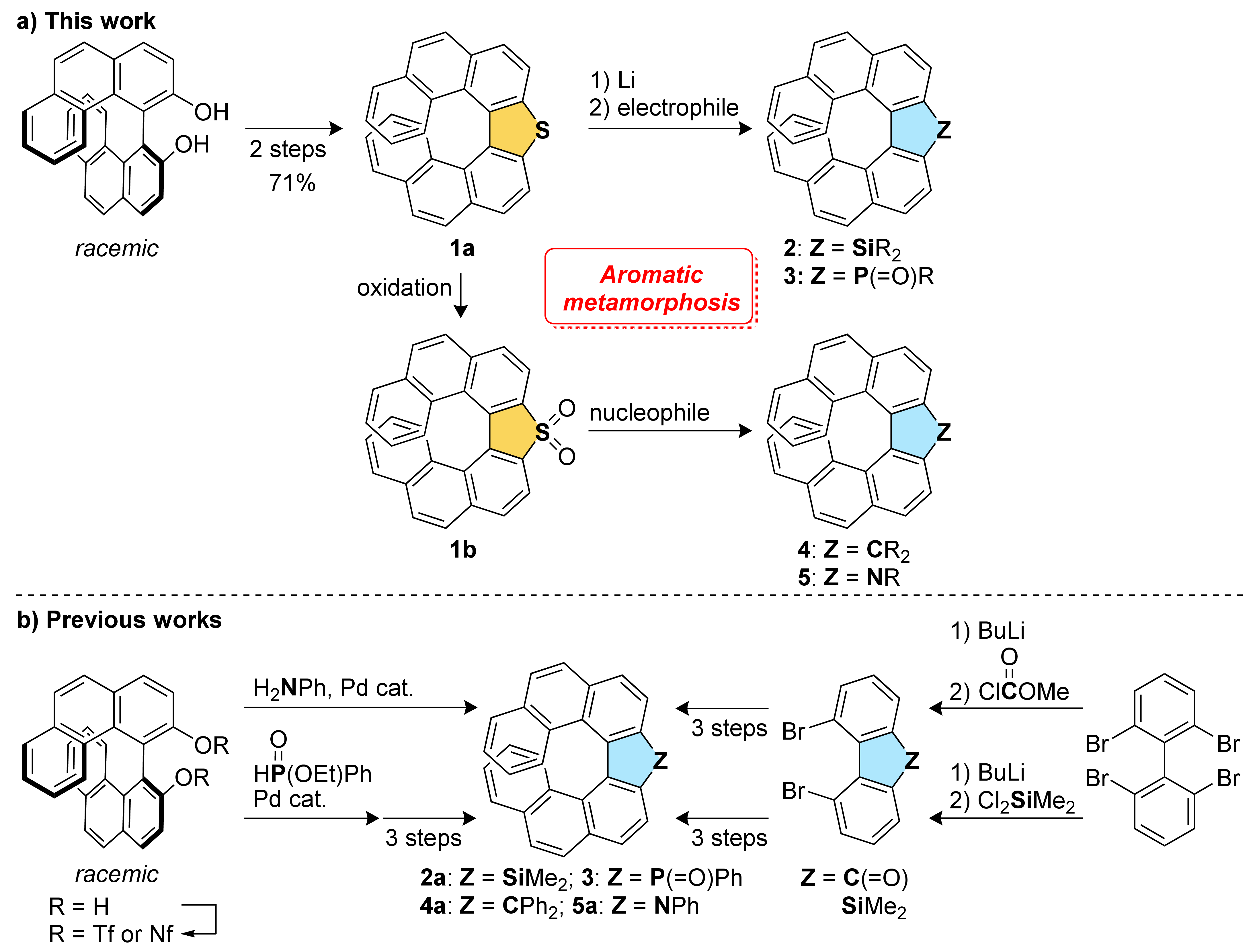
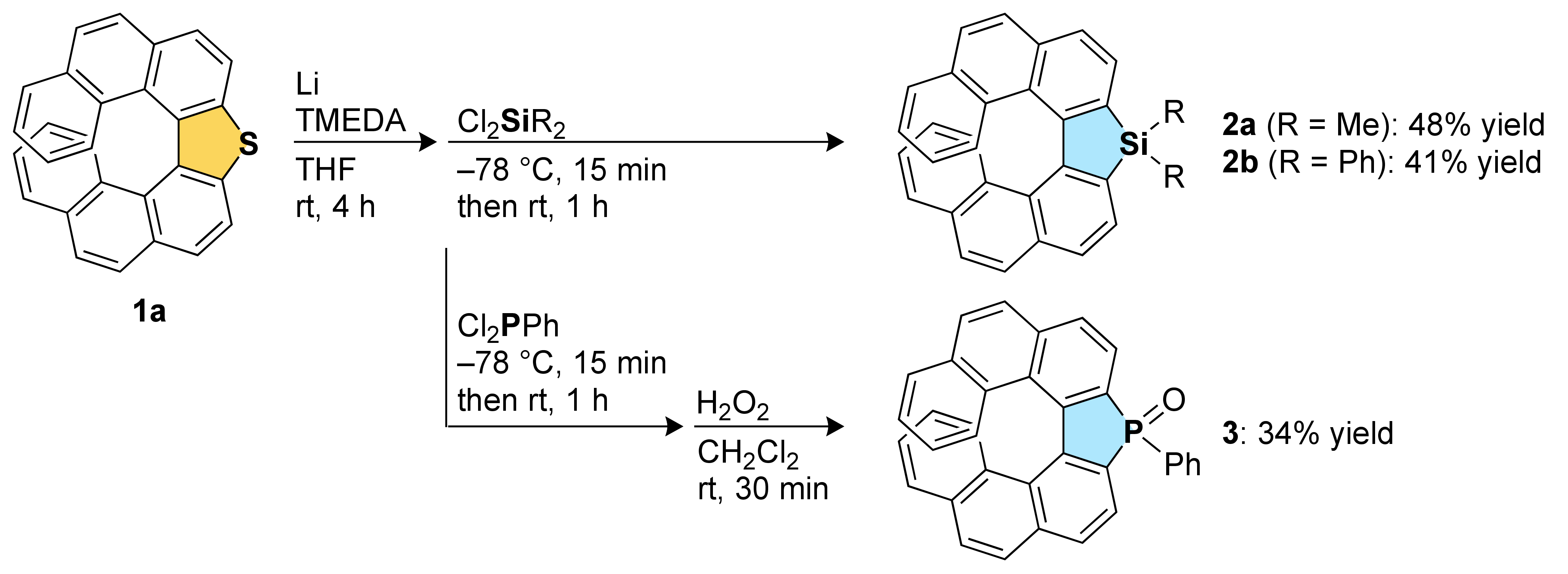
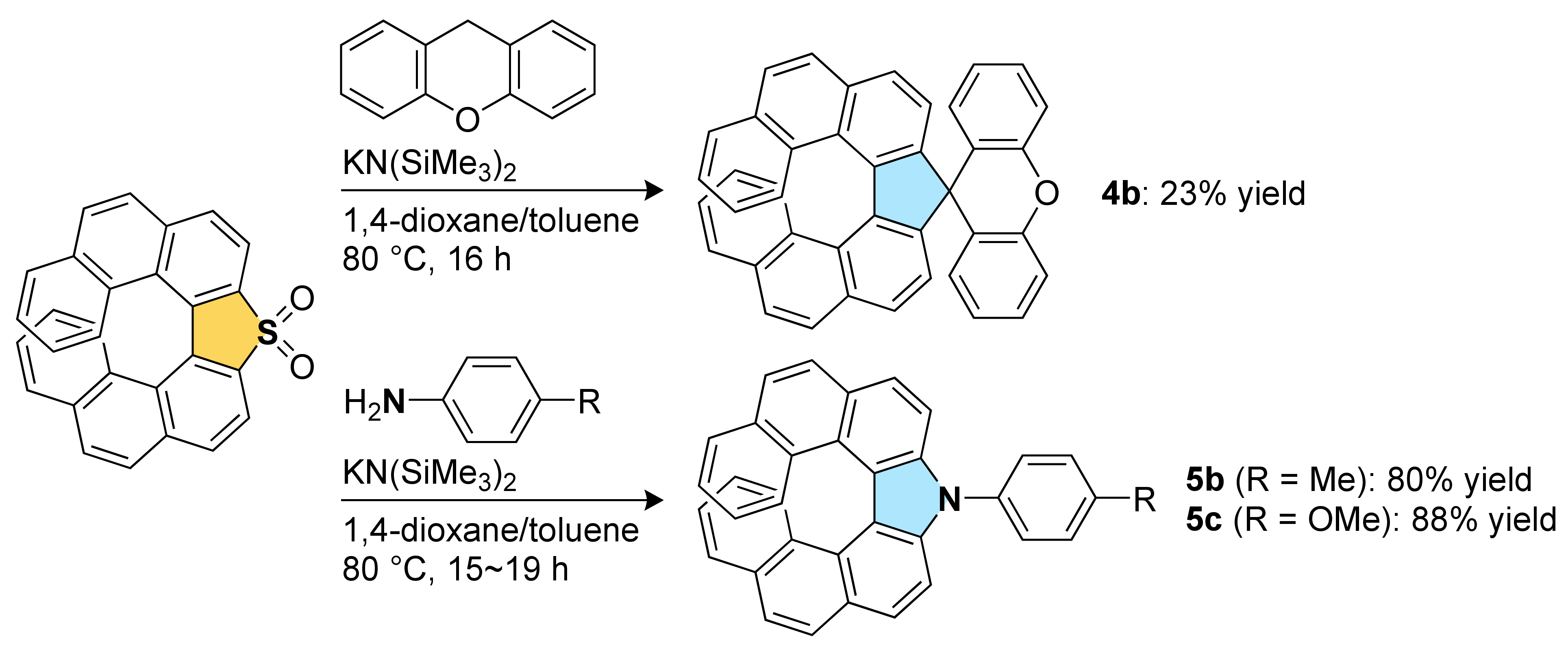
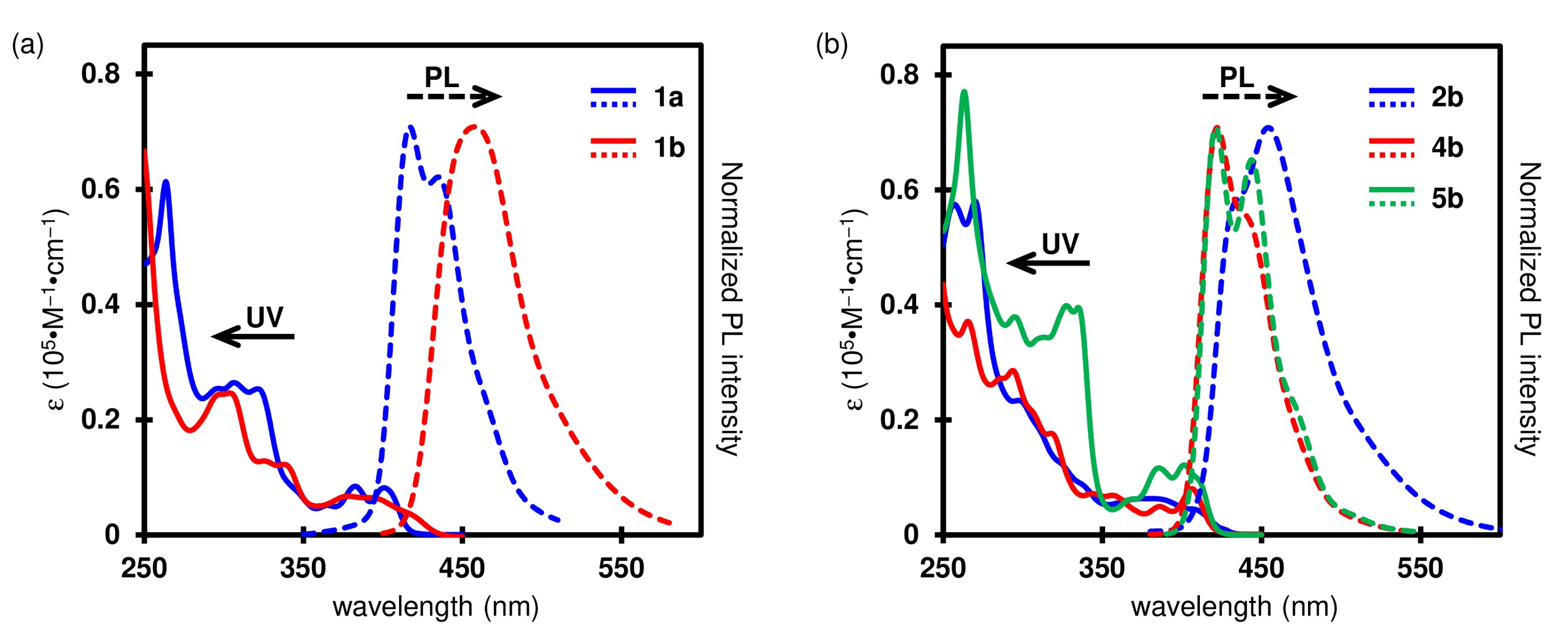
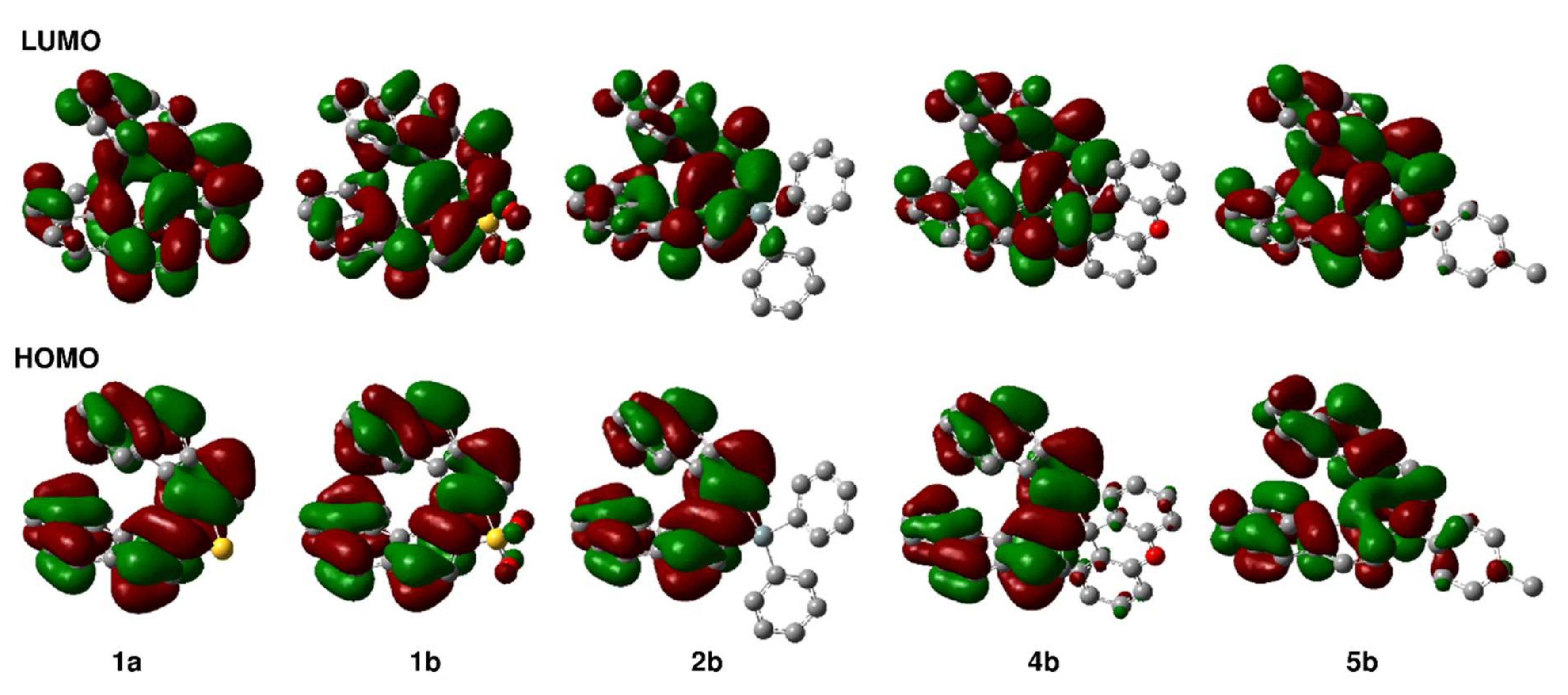
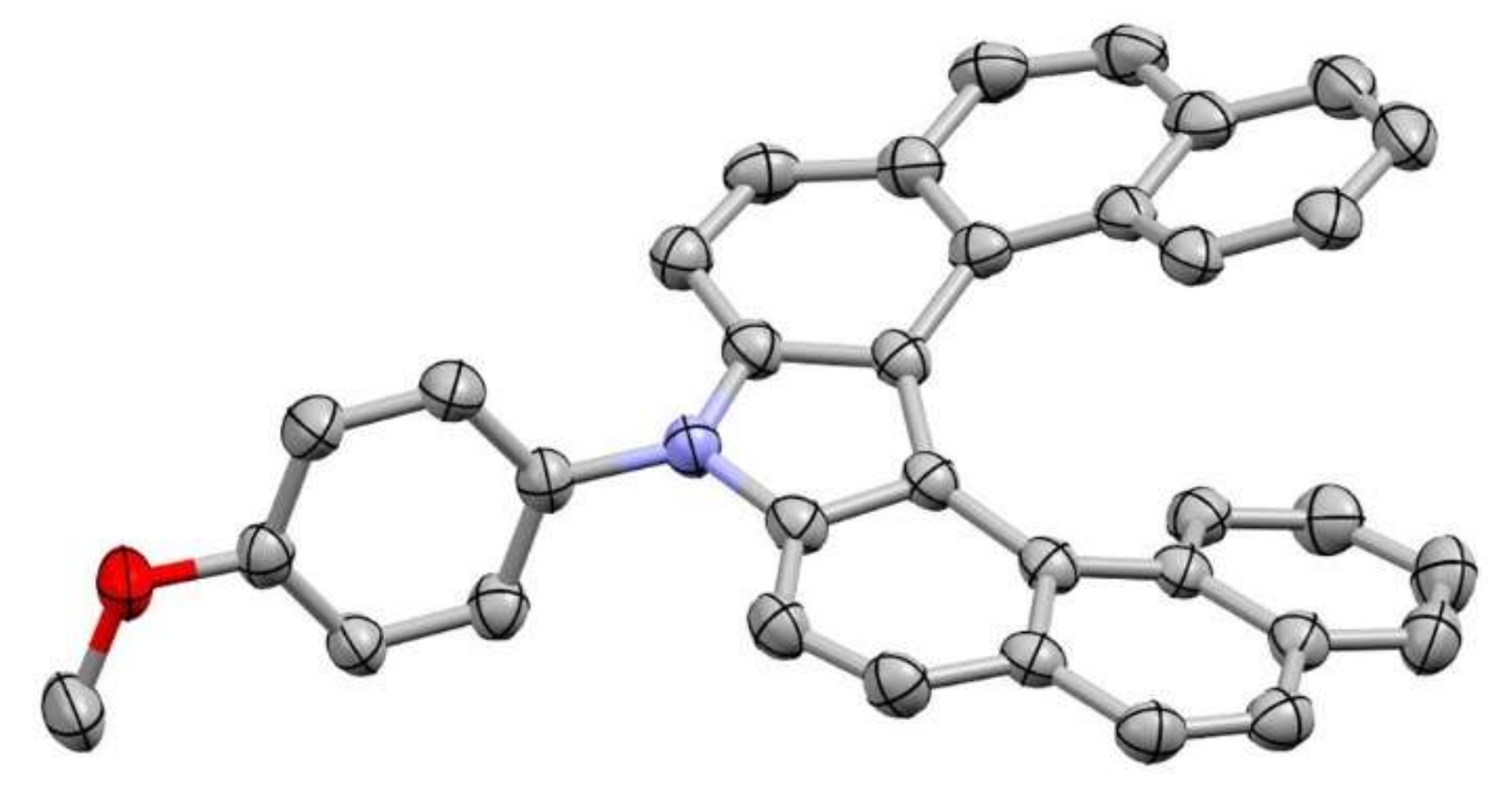
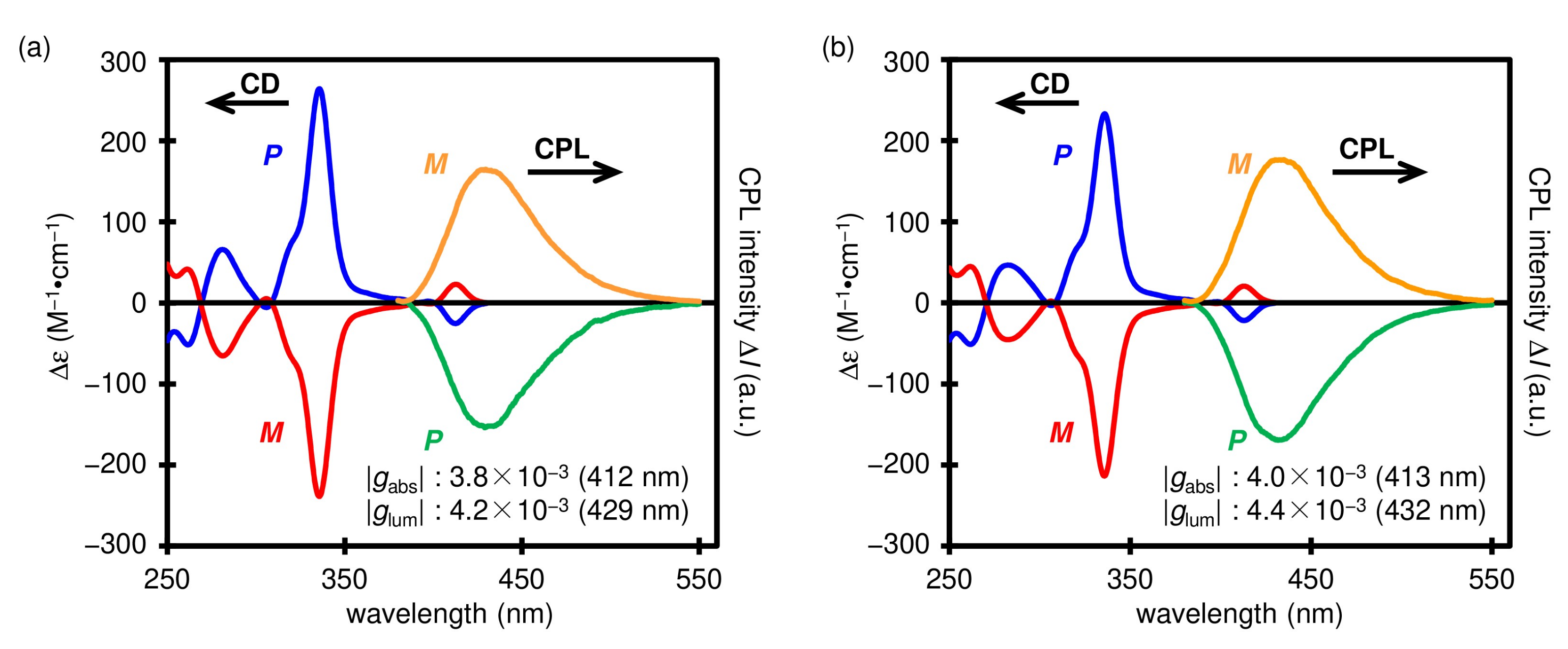
| λabs (nm) a | λem (nm) b | ϕ c | |
|---|---|---|---|
| 1a | 401 | 417, 435 (sh) (265) | <1 |
| 1b | 395, 415 (sh) | 458 (300) | 4 |
| 2b | 389, 411 (sh) | 434 (sh), 454 (325) | 11 |
| 4b | 406 | 422, 441 (sh) (294) | 31 |
| 5b | 401 | 421, 444 (335) | 17 |
| 5c | 401 | 422, 445 (335) | 16 |
| 2ad | 412 | 450 (320) | 23 |
| 4ae | 408 | 421, 441 (sh) (340) | 40 |
| 5af | 400 | 418, 442 (330) | 17 |
Publisher’s Note: MDPI stays neutral with regard to jurisdictional claims in published maps and institutional affiliations. |
© 2022 by the authors. Licensee MDPI, Basel, Switzerland. This article is an open access article distributed under the terms and conditions of the Creative Commons Attribution (CC BY) license (https://creativecommons.org/licenses/by/4.0/).
Share and Cite
Uematsu, K.; Hayasaka, C.; Takase, K.; Noguchi, K.; Nakano, K. Transformation of Thia[7]helicene to Aza[7]helicenes and [7]Helicene-like Compounds via Aromatic Metamorphosis. Molecules 2022, 27, 606. https://doi.org/10.3390/molecules27030606
Uematsu K, Hayasaka C, Takase K, Noguchi K, Nakano K. Transformation of Thia[7]helicene to Aza[7]helicenes and [7]Helicene-like Compounds via Aromatic Metamorphosis. Molecules. 2022; 27(3):606. https://doi.org/10.3390/molecules27030606
Chicago/Turabian StyleUematsu, Keisuke, Chikara Hayasaka, Ko Takase, Keiichi Noguchi, and Koji Nakano. 2022. "Transformation of Thia[7]helicene to Aza[7]helicenes and [7]Helicene-like Compounds via Aromatic Metamorphosis" Molecules 27, no. 3: 606. https://doi.org/10.3390/molecules27030606
APA StyleUematsu, K., Hayasaka, C., Takase, K., Noguchi, K., & Nakano, K. (2022). Transformation of Thia[7]helicene to Aza[7]helicenes and [7]Helicene-like Compounds via Aromatic Metamorphosis. Molecules, 27(3), 606. https://doi.org/10.3390/molecules27030606







